The Wet Season — Preparing for Your Trip
People who are properly prepared will enjoy our wet season trips far more than those who are not. This page should show you exactly what you need to do so that you can get the most out of any wet season trip you choose.

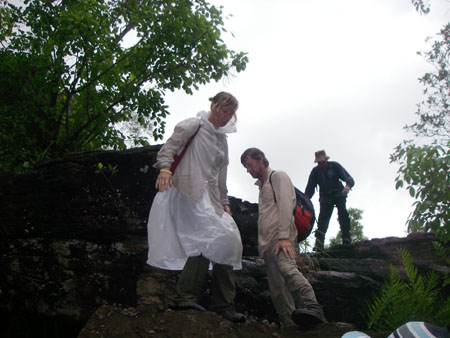
A positive mental attitude is more important than anything else you can bring. It will be hot, humid and somewhat physically challenging — just how challenging depends very much on the individual. If you can accept that, you are well on your way to having a wonderful experience.
You are going to get wet. Most people simply accept that as shown in the first photo on the previous page. However, it can get a bit chilly, never cold, but a bit chilly if you are having a break or doing an easy walk while it's raining. A heavy raincoat is weight you don't need but a lightweight (about 50 g) plastic poncho can be worth while. I (Russell Willis) always carry a small poncho on wet season trips. I've used it once. I went through every digital photo I had. The only one with someone wearing a poncho is the one at right. I can't recall ever having seen someone wearing a normal raincoat on a Top End or Kimberley trip.
Alternatively, you might wish to carry a small, lightweight umbrella. This has the additional advantage of allowing you to take photographs with an ordinary camera when it's raining. If you don't have a waterproof camera, that is something you surely will wish to do. The umbrella photo at the far right emphasises the fact that we walk off trail. The grass we walk through isn't often this tall but you have to be prepared for when it is.
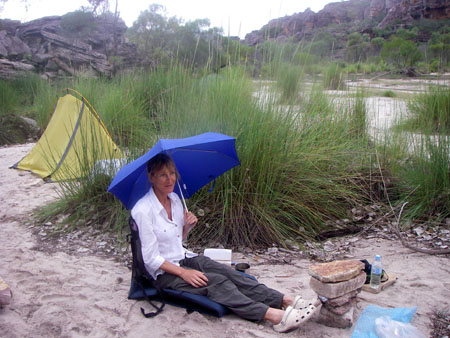

Umbrellas are surprisingly useful, more so than ponchos. Ponchos and raincoats don't breathe. Umbrellas let the air get at you. For example
- You might use one in camp during a short shower.
- You might use one as a sunshade on a sunny day as at the near left. This was taken on a light pack trip in Nitmiluk, one of the few places we walk on a marked trail.
- If it's raining, the Walkabouts guide often uses one to shelter the fire when getting it started.
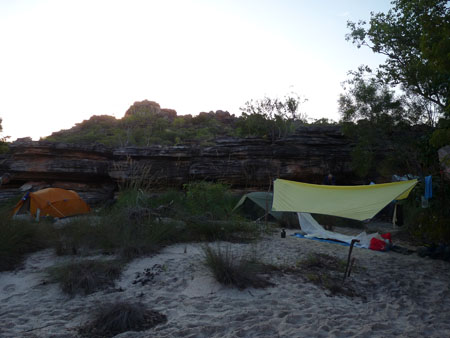
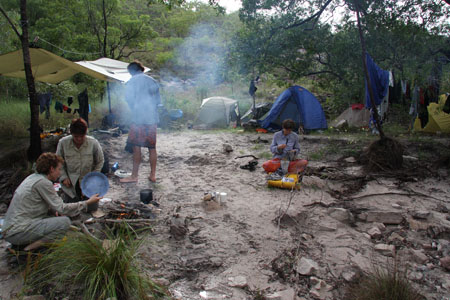
Shelter and bedding. You do not need a sleeping bag. In Kakadu, the average nighttime minimum temperature in the months of January through March is about 24°C. The all time record low for those months is a bit over 20°C. Something like a sarong is all that most people need for bedding. There is no warm clothing or bedding hanging out to dry in the photo at right. No one brings it.
It's also worth mentioning that the record maximum is only 38°C — even Hobart has recorded a temperature of 42°C. It's hot, but not unbearably so — especially when there are so many pools inviting you to enjoy yet another swim.
You do need to be able to keep the rain off at night. Most people choose to bring a tent (the more netting the better) with a fly. Some as shown at the far right, simply bring a fly and hang a mosquito net underneath. That's not always easy to do, but it does keep the weight down.
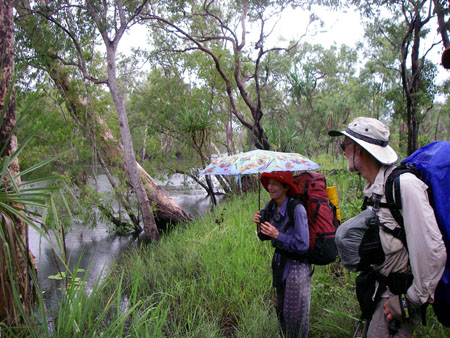
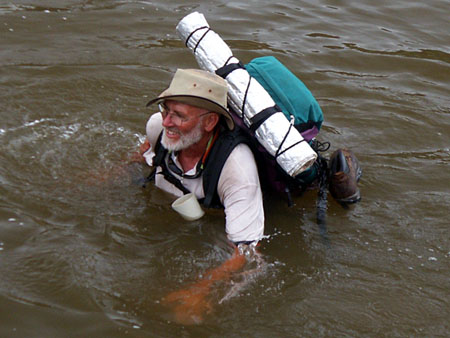
Keeping your things dry. In the picture at the far left, one person has a pack cover, the other does not. The contents of both packs are dry. In the near left picture, the person in the water tried a short cut that was a bit deeper than he expected. He's still smiling. Why?
Two reasons. The water isn't cold and he's enjoying the swim and, more importantly, he has a pack liner inside his pack. No pack is totally waterproof. No pack cover is totally indestructible. If you want to do a walk in the wet season, you need a decent pack liner to ensure the contents of your pack stay dry.
If you have a good camera, the photo at far left shows something else important — a camera cover. Most cameras are not designed to survive getting wet. A good camera cover and a separate dry bag will allow you to keep your camera dry no matter what the weather may do.

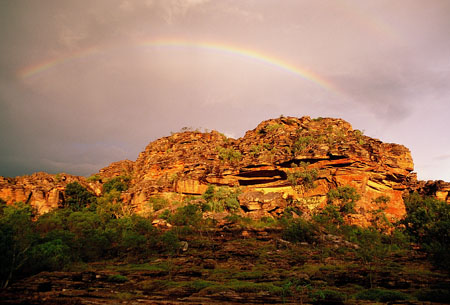
Rock shelters. Aboriginal people have been using rock shelters for thousands of years. We know where they are and often visit them. The near photo was taken from a rock shelter in Kakadu where we'd just finished a late lunch. The photo at far right was taken in a rock shelter near the Victoria Highway in Gregory national Park. We'd stopped to shelter from a rain squall and enjoy the view.


Camping in rock shelters is not permitted in Kakadu. There are, however, a number of shelters we can use on some of our Kimberley trips as long as we stay well clear of any paintings that may be n the area.
The near photo is of a small rock shelter in the Carr Boyd Range. the far photo was taken in a downpour. You can see water falling from the cliffs above yet we didn't need to put a fly on some of the tents.
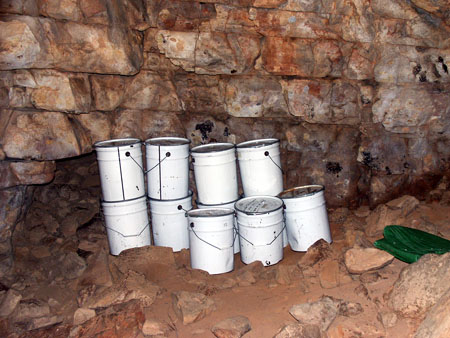
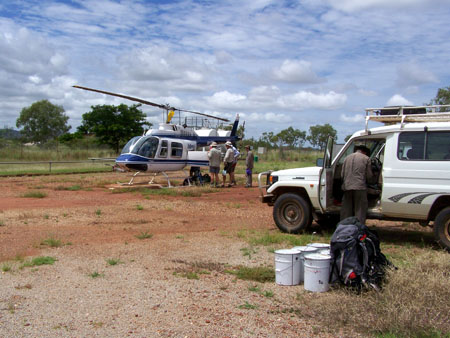
Food drops. On some trips we use food drops to minimise the amount we have to carry. Food is stored in sealed metal drums and then left in caves or other shelters. In Kakadu, the drop may sit for up to six months before being used. That was the case with the drums shown in the photo at the far right. In the Bungles, we bring it in with us so it only has to sit for a week.
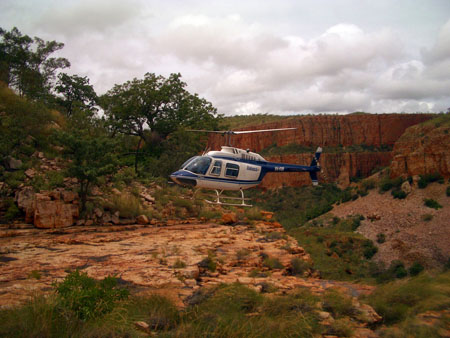
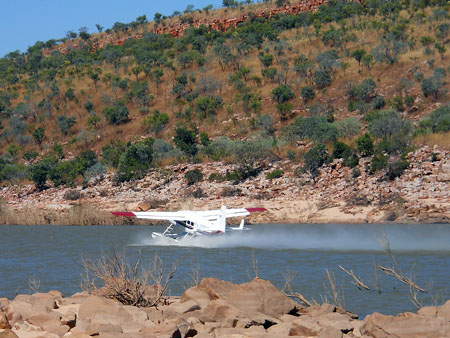
Getting to the walk. Even in the dry season, many of the places where we walk cannot be reached by 4WD. In the Wet, access is even more limited. If we can't drive, we use a combination of helicopters, boats and amphibious aircraft to get to places where we are going to walk.
The two photos at the left were taken in the Kimberley, a helicopter to the Cockburn Range and an amphibious aeroplane to the Durack River.
Now back to some more of the personal essentials you need to consider before you come.
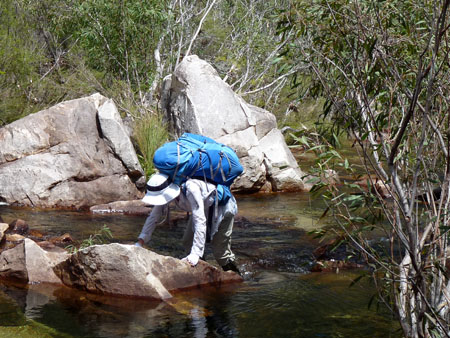
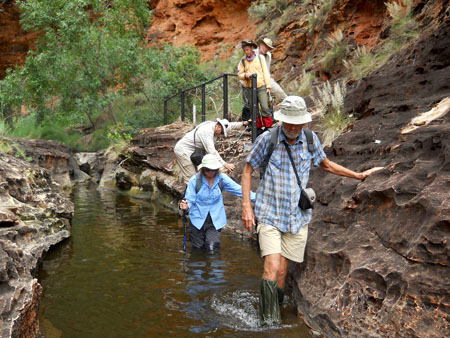
As stated on the previous page,
"On all of our wet season trips, you are going to be walking through water." The near right photo shows walking along the Cathedral gorge track in the Bungles in February. Later in the year, it will be bone dry.
The photo at far right shows someone wading across Kurrundie Creek in Kakadu on one of our Kakadu Highlights trips. Some crossings are a bit difficult as well as a bit deep. There are, however, ways to make thing crossings substantially easier.
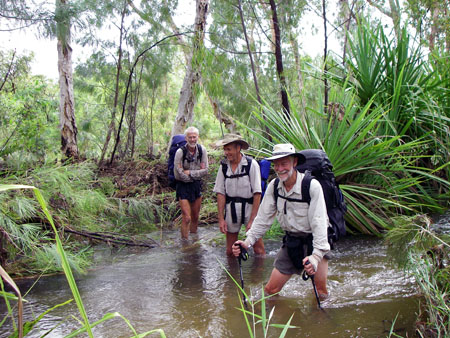
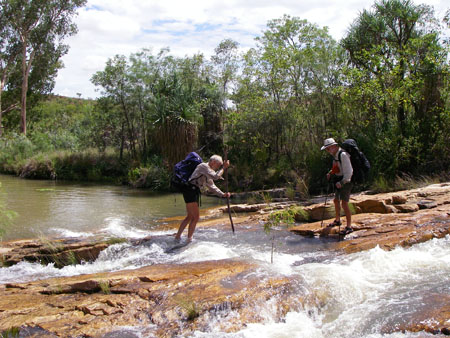
Trekking poles and walking sticks. Some people normally use trekking poles and find that they help with the creek crossings.
Those who don't have trekking poles can almost always find an appropriate size stick to help them as shown at the near left.

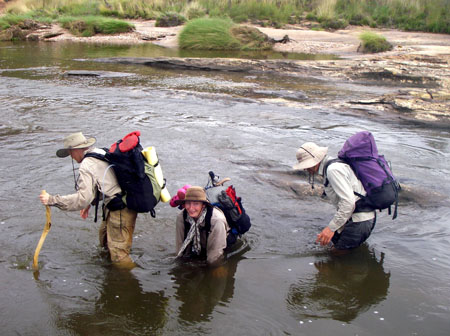
Have a good look at the photos at the right.
In the first photo, the woman in front is using a stick and finding it relatively easy. The woman in the middle, still smiling, found it easier to get down low enough to use her hands. The man in the back is upright, but finding it harder than the woman with the stick.
The photo at far right shows two people wading down a long stretch of Piccaninny Creek in a drier time. They are carrying their boots — leather boots.
We do not recommend leather boots in the wet season. Some people bring them anyway. In any case, you need to be aware that, on some trips, your boots or shoes might not dry out for the entire trip. There are many other options — for the main walk, for crossing creeks and around camp.
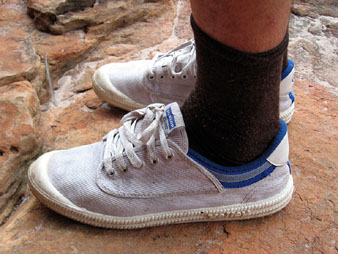
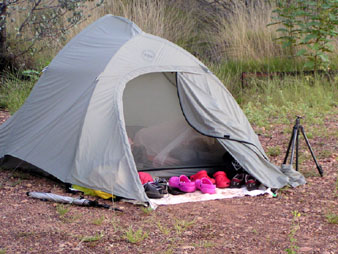
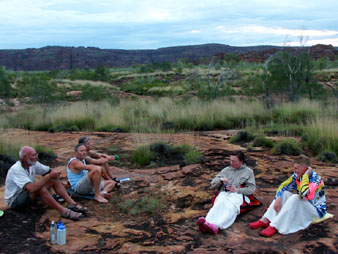
Footwear is important! Some brands are better than others but we have seen even the most expensive boots fail while other much cheaper ones survived. So, what do we recommend?
The first thing we recommend is that you have something to wear around camp that can be used in an emergency if your main footwear fails. Look at the first photo at right (click to see a larger version). Two people are wearing crocs, two are wearing sandals, one is barefoot. If you are used to going barefoot at home, you can probably get away with it around camp. If you don't go barefoot a lot, we strongly recommend you bring something light to wear around camp.
The middle photo shows the shoe collection for the two women in the first photo — runners for the main walk, crocs for camp. The final photo shows a pair of Dunlop Volleys someone else had on that same trip. Volleys wear out fairly quickly. They offer almost no support or padding. But they grip on wet rock like almost nothing else.
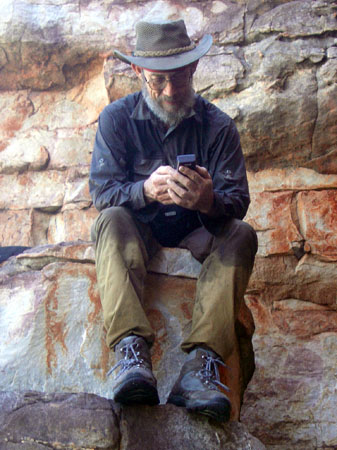


Boots or shoes?
If you have weak ankles or if you've never done much off-trail walking, bring boots. A sprained ankle could destroy your holiday.
Having said that, I normally prefer runners but may choose either. The photo at far left shows me wearing fabric boots on a wet season Bungles trip. The centre photo shows me wearing runners on a longer, more strenuous wet season trip a year later.
Gore Tex doesn't breathe in the tropics. You want a fabric boot that will handle the continually wet conditions. Different boots fit different people. Brands can change from one year to the next. There is no brand we can recommend above all others but one thing I can say without hesitation is don't bring an old pair that is anywhere near needing to be replaced. A well-worn pair of boots may be comfortable, but we've seen too many failures. Getting a new pair of untested boots or shoes sent in with a food drop is sometimes possible — we've done it often enough — but it is not recommended.
Finally have a good look at the near photo. Click to see a larger version if you need to. The person in the photo is on a long day walk from a base camp in the Bungles. He chose to wear sandals for the day and had no problem doing that. (Sandals wouldn't work as well in thick scrub, but even there, a good pair of sandals could be used as your main footwear if your normal boots or shoes had perished.
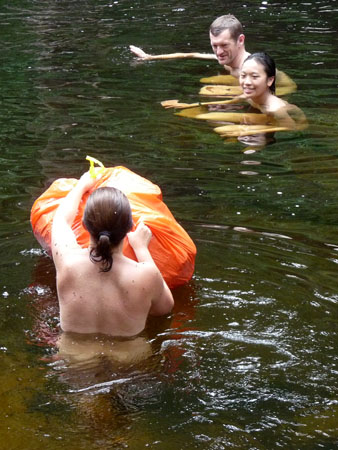
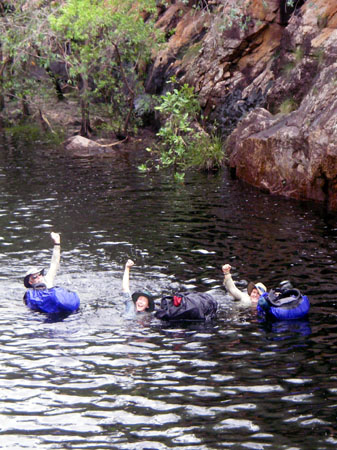
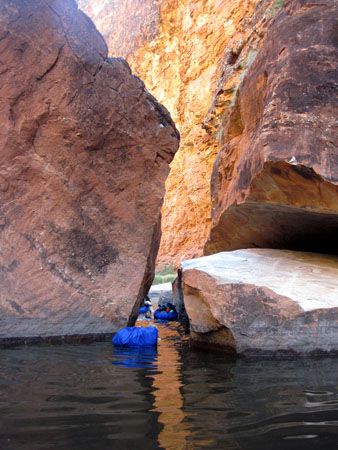
Floating your pack. Sometimes you do it because you have to. Sometimes you do it because it's fun. Floating packs was an option in the three photos at right.
In the near photo, in the Bungles in February, the group had the choice of climbing around through the spinifex or floating through the gorge. They chose to float.
In the middle photo, taken our Kakadu Super Circle trip in January, the people in the water preferred to swim rather than walk along the wet rock at the side. (The photographer chose to walk — that's why we have the photo,
In the final photo, taken at Gubarra in kakadu on one of our New Year trips, some people chose an easy pack float rather than a moderately deep wade further downstream.
In all three cases, they could have walked but floating the packs was more fun.
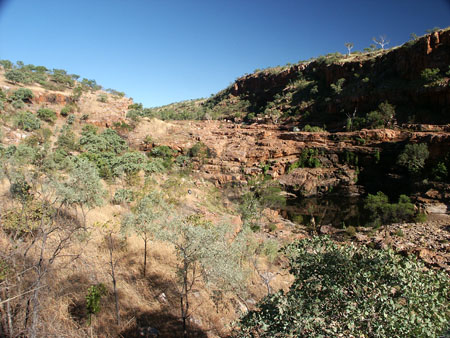

Waterfalls, waterfalls and more waterfalls. Waterfalls are one of the things that makes walking in the wet season such a delight. We couldn't possibly leave a page like this without a few more waterfall photos.
The two photos at left are of the main falls on Packsaddle Creek in the Carr Boyd Range in the Kimberley. they were taken from slightly different vantage points, but they do show the same area. The one at far left was taken in May. The closer one in February.
The first two photos below are of the same waterfall on 'Many Falls Creek' in the Carr Boyd Range in the Kimberley. The first one with the blue sky was taken in January. The second, with a grey sky was taken in May.
The third one is a January photo of the Top Falls on Cascades Creek in Kakadu. The final one shows you don't need to do a major expedition to enjoy the wonder of the Wet. It was taken at Edith Falls on one of our light pack trips, only half an hour from the car park.
What Happens When Things Go Wrong?
Accidents don't happen often, but they do happen. We carry a satellite phone and a backup EPIRB on all our major expeditions. If you were to have an accident that required medical attention, help would be some hours away, similar to what would happen if you had an accident on a remote rural road in Australia. That's the human factor.
Mother Nature can deliver some truly extreme events. Normal wet season conditions in the Top End and Kimberley might be considered extreme in other parts of the country, but here they are nothing special. Occasionally, however, we do get something that goes way beyond the normal.
In April 1985, before Willis's Walkabouts ran it's first trip, I (Russell Willis) was doing a walk with some friends in Kakadu when the tail end of Cyclone Gretel dropped an incredible amount of rain. The three pictures below show what it was like. All were taken from within 50 metres of each other, the first late one April afternoon, the second and third the following morning after the tail end of the cyclone came through. (Where we walk in Kakadu is too far inland for cyclonic winds but not too far for the associated rain.) When we arrived, it was easy to step across the creek. The following morning it had turned into a spectacular torrent. We spent most of the day dry and comfortable in a nearby rock shelter, stepping out every so often to enjoy the magnificent views. The next morning the rain had stopped and we moved on, feeling privileged to have been able to experience the might of the wet season in such comfort. The next morning the rain had stopped and we moved on, feeling privileged to have been able to experience the might of the wet season in such comfort.
That adventure was not yet over as the pilot of the helicopter which had been scheduled to pick up up got stuck in Darwin so the pick up arrived a day late. We were a bit hungry but the tale we had to tell made it more than worth it.
In January 1995, a monsoonal depression sat over one of our Kakadu Super Circle groups. the three photos below give you a hint as to what it was like. The first is a view of Jim Jim Falls from about 10 km away. The second is at the top of Twin Falls where they waited for three days until the river was safe to cross. The third is nearing the end of the pack float when they finally crossed the creek. They had to push a bit harder to finish the trip on schedule, but they did it and are still talking about the experience today.
In March 1995, Cyclone Chloe struck while we were doing a Kimberley Coast trip. We had to sit for three days waiting for a normally tiny creek to drop to the point where it was safe to swim across. The rain passed and we continued on for another two and a half weeks.
You can read a report that one of our clients wrote about that on this website. That report links to a 1995 Kimberley Coast photo gallery. The photos are a bit small, but it was pre-digital and we don't have better scans.
In February 2011, Cyclone Carlos dropped an all time record amount of rain on Darwin during a Kakadu Light trip. On the first of the few nights we camped out, a massive storm caused the creek to rise and flood the group fly as shown in the first photo. (We always camp on high ground in the Wet but sometimes we set up the dining area near the creek. Once in a while that's a problem, but not for long.)
In less than an hour, the fly had been moved to higher ground and dinner was cooking on the fire. The third photo shows just how traumatised one of the clients felt.
The floods forced some later changes to the itinerary, but they allowed us to see things we never would have been able to see in a normal year.
In January 2014, one of our groups had to spend two nights at Twin Falls waiting for the creek to drop to a level where it was safe to swim across.
Flexibility is the key. Since 1986 when Willis's Walkabouts began, Mother Nature has thrown up a few challenges — far fewer than most people might expect. To date, we've coped. Not only have we coped, we've turned those challenges into great experiences for all concerned.
We'll finish this page with a final selection of photos of people on our wet season trips doing what we like to see more than anything else — enjoying themselves. Hold your cursor over the photos and you'll see a detailed caption.
Relaxing in the shade.
Posing for a photo.
Enjoying the view; enjoying the water.
Want to come? You're almost there!
- From Christmas through March, every trip in Kakadu and the Top End and in the Kimberley is a wet season trip.
- Everyone who does any of our trips, wet season or dry, needs to read out Bushwalking Guide. Read it now or later, but you must read it before you come on a trip.
- Our General Information sheet has details about how we rate the level of difficulty of our trips, our discounts and cancellations fees.
Have any questions? Please send an email to walkabout@bushwalkingholidays.com.au
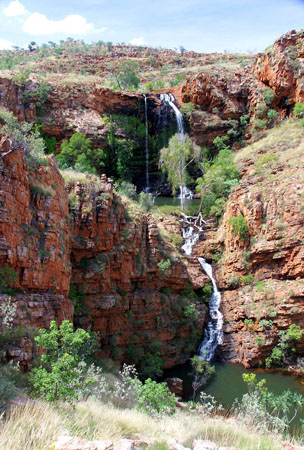




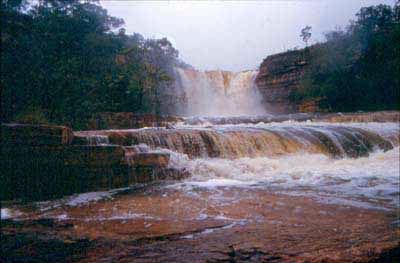
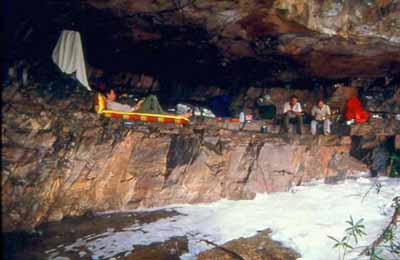

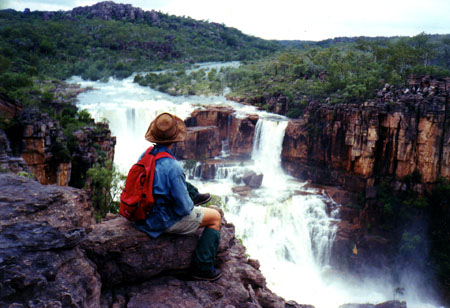
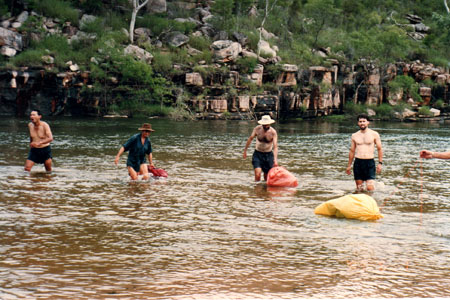

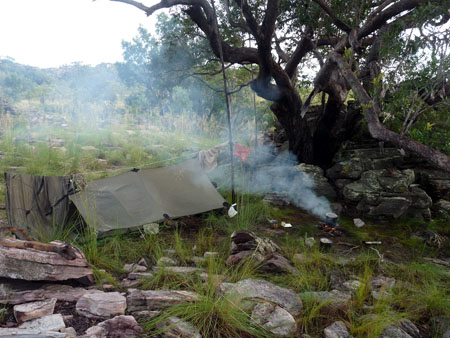


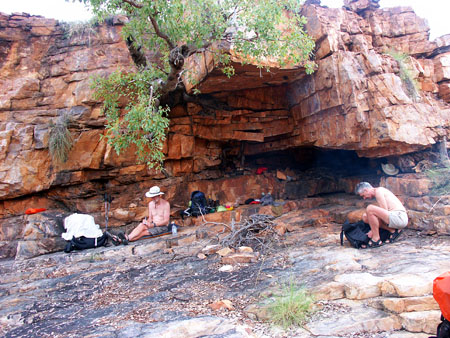

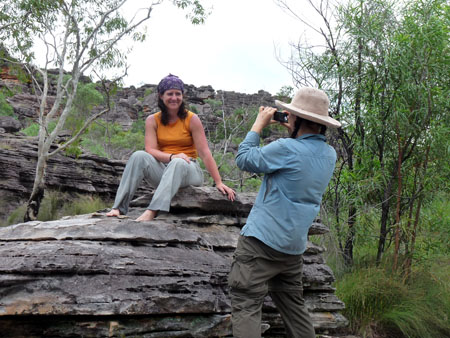
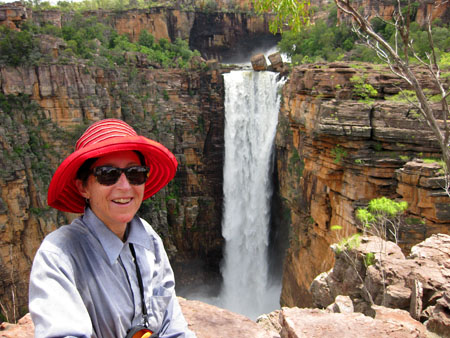

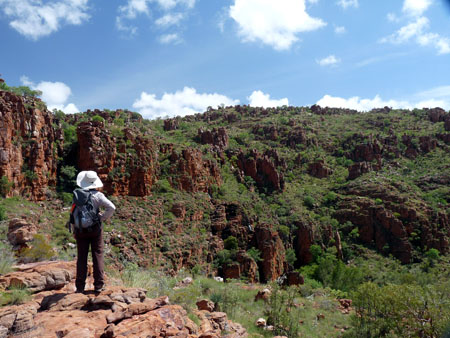

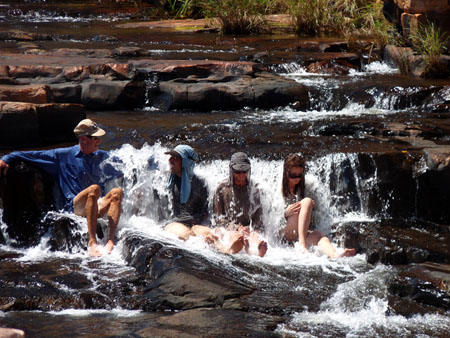
 share
share